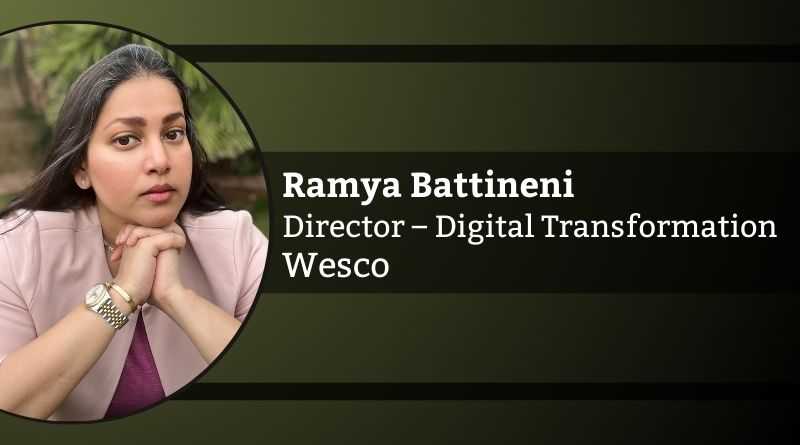The New Age of Leadership
By Ramya Battineni, Director – Digital Transformation, Wesco
In the era of Globalization, Leadership styles relying largely on ‘Command & Control’ are no longer effective. The top-down leadership model is being replaced by more collaborative leadership models promoting ONE team culture. Many Leaders transitioning from traditional to new age leadership are fostering autonomy and empowerment of employees driving higher engagement and productivity. But the real question is, do your teams actually ‘feel’ empowered? Through their actions, are they showing strong signs of autonomy? If the answer is no and these concepts are limited to Townhalls, Staff meetings, and one-on-one sessions, it is time to take a closer look at the overall eco-system and make improvements.
What is an ecosystem? It is a network of interconnected organizations and individuals that collaborate and improve the creation & delivery of value. In today’s dynamic and complex environment, Building, promoting and sustaining a cultural eco-system that emphasizes Psychological safety, Employee Well-being, Diverse work force with different generations and cultural backgrounds, promotes collaboration, innovation and adoption of new technological advancements and the framework/operating models to shift plans, quickly and efficiently is key. Leadership plays a crucial role in continuously improving and simultaneously maintaining the cultural ecosystem.
The New era leaders can become great leaders and create a lasting impact on their followers by showing up as humans bringing their whole, best, authentic selves.
A healthy cultural eco-system has a direct positive impact on attracting and retaining top talent, employee engagement and motivation, how people interact and collaborate within the organization leading to increased productivity and innovation. An organization’s existing eco-system can be made better or worse when we hire new talent. The “new age of leadership” hiring practice is all about finding candidates that is a careful balance between skills, growth mindset, and technological advancement. It is also important to strike a balance between Culture Fit and Culture Add. While it is a good practice to hire candidates who can culturally fit within your organization, More companies are also looking for candidates who can add to their culture, i.e., make their culture better. Although Organizational culture is not something that changes constantly, it is subject to evolution as a result of external and internal factors such as Market shifts, societal changes, Organizational growth and Mergers & Acquisitions.
Promoting someone to a management role solely based on their technical expertise is a common and often very costly mistake. Leadership and technical knowledge may overlap sometimes, but they are distinct skill sets. Technical experts struggle with delegating and trusting team members due to their deep knowledge in the subject matter, which leads to micromanagement, resulting in demotivated teams, decreased productivity, and higher employee attrition. Instead of directly promoting a technical expert to a management role, give them a trial period and gather 360 degree feedback to help self-reflect and prepare them to be a successful leader.
For a leader to transform into a great leader, being purpose-driven and ethical, authentic and transparent, empathetic and emotionally intelligent, and having a continuous learning mindset are essential. Nowadays, ‘Authentic Leadership’ is a popular term in leadership and management circles. Authenticity is NOT to be confused with simply being your original-self. It is to be our whole BEST selves, characterized by self-awareness, genuineness, aiming to build trust and inspire followers. A great leader breaks hierarchical barriers of communication between the leader and all the levels below, enabling true transparency all across. Similar to how children mimic their parents by observing them, employees unconsciously mimic their leaders’ actions and attitudes. It is crucial for leaders to be mindful of their behavior. Oftentimes, employees adopt their leader’s communication style, work ethic, decision-making, Interpersonal behavior, and morale.
New era leadership has made a clear shift from a mindset of authority to a mindset of partnership. The difference between authority and partnership is the same as your employee feeling they work ‘FOR’ you instead of they work ‘WITH’ you. Leaders should clearly define target Outcomes & Key Results (OKRs) to achieve, provide a healthy eco-system and resources for teams to determine HOW to achieve the OKRs defined by the leadership. This helps teams practice empowerment and autonomy in real-time, on a day-to-day basis, leading to decentralized decision-making, an increased appetite for experimentation, out-of-the-box solutioning, and an overall shift from being order-takers to delivering innovative solutions.
In conclusion, The New era leaders can become great leaders and create a lasting impact on their followers by showing up as humans bringing their whole, best, authentic selves. It is essential for a leader to transform their inner state to feel secure in themselves at all times to effectively lead, build, and support a healthy ecosystem where teams feel encouraged and comfortable sharing their ideas and taking risks. As humans, our natural instinct is to survive. As leaders, we should allow ourselves to be more candid and vulnerable, enabling open and honest dialogue. In short, be the leader you wish you had.

